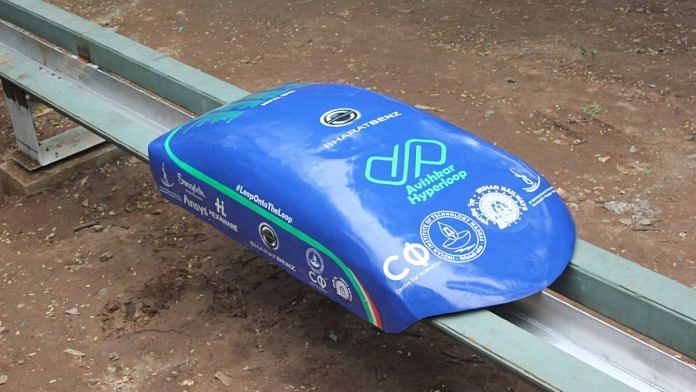New Delhi: Imagine a pod or compartment of passengers that runs inside a tube in partial vacuum and ferries them from Chennai to Bengaluru — a distance of around 350 km — in just 30 minutes.
The high-speed transportation system, running on hyperloop technology, may become a reality in India in 10 years, says a team of over 50, comprising undergraduate, post-graduate and doctoral students from the Indian Institute of Technology (IIT) – Madras, working on the project titled ‘Avishkar Hyperloop’.
Medha Kommajosyula, student team lead of ‘Avishkar Hyperloop’ project, told ThePrint, “This year we are very close to validating our concept, meaning proving our hypothesis with a physical experiment.”
“If we continue working at the pace we are going at right now, we may be able to build the first working hyperloop rail of scale in the next 10 years or so,” she added.
The hyperloop system, an idea credited to billionaire entrepreneur Elon Musk, uses magnetic propulsion to accelerate pods in partial vacuum, allowing them to travel at extremely high speeds — up to 1,000 km per hour — due to the lower air resistance.
IIT Madras’s Avishkar team claims it is among the few student-led teams in the world that has been able to construct such a pod, run it through a tube and prove the concept of hyperloop.
Professor Satyanarayanan Chakravarthy, the faculty adviser for Avishkar Hyperloop, told ThePrint: “As of now, the team is in the initial stages of demonstrating a sub-scale hyperloop model. They are currently in Scotland demonstrating the levitation of the pod created by them.”
According to the team, they have so far applied for six patents for the technologies used in the making of hyperloop rail, including for the technology used in making the tube, the levitation and propulsion system for the pods and the cooling architecture for the battery.
Medha added, “As of now, we are looking at how to make an air-conditioner functional in a pod inside a vacuum. Also, what kind of ventilation and how many people can be seated are some of the things we need to figure out”.
The Ministry of Railways had last year given funding of Rs 8.34 crore to IIT-Madras for a collaborative project on hyperloop technology. The allowance came after the institute had submitted a research proposal to the ministry to collaborate and indigenously develop a hyperloop-technology based transportation system and its subsystems.
Also Read: First crewed hyperloop pod tested — all about the tech that cuts travel time by hours
Genesis of the project
Explaining how the IIT students started working on the hyperloop project, Medha said the Avishkar team had participated in the SpaceX Hyperloop Pod Competition in 2018, in which student teams and hobbyists design and build a prototype transport vehicle, demonstrating the technical feasibility of various aspects of the hyperloop concept.
Since they participated in the competition, the team has been working on the project. “It is very exciting to see that what started out as a fun activity has now become something that could change the way the country travels,” said Medha, a third-year student in IIT’s dual degree engineering design course. She also manages corporate relations for the Avishkar project.
“We finish our classes and immediately hit the labs to start our day’s work on the hyperloop project. We intend to only stop once it is functional,” she added.
The other members of the team include Shrid Suresh, a third-year BTech mechanical engineering student, who heads the concept validation and project planning side of the project; Ankit Bansal, a second-year Master’s student of material science who leads the unit working on scalability of systems; and Siddhant Patole, an undergraduate civil engineering student who is the team lead for infrastructure development.
The team said that while they work on multiple aspects of engineering for the hyperloop project, many of their professors from different departments help them out whenever they need area-specific guidance.
‘Speed of air travel, cost of train travel’
Professor Chakravarthy told ThePrint that the hyperloop system could change the way people in India travelled, and that the team of IIT students was “aiming to bring the speed of air travel at the cost of train travel”.
The Avishkar team thus has members working on cost reduction for the transport system.
“If we were to lay down a 350-km tube in India, 70 per cent of the total project cost would go in just laying down the tube. So, we are specifically looking at using metals which are cost-effective to build structures that require minimum expense,” Patole said.
Last year, IIT-Madras received funding from Larsen & Toubro to build a 400-metre vacuum tube in Chennai to test the concept of hyperloop.
Professor Chakravarthy said that over the next two years, the Avishkar team would work in collaboration with Tata Steel as well as L&T to build a hyperloop rail model of scale which will have the potential to be implemented across the busiest inter-city corridors of India, including Mumbai-Pune, Delhi-Agra, etc.
Speaking about the ease of travel, he said: “Once operational, we expect the hyperloop rail to run at an interval of every 2.5 minutes and tickets will cost about Rs 1,500. This will change the way inter-city travel works in India.”
He added that currently, the cost of building high-speed rail is about $27 million per km the world over. “Team Avishkar aims to build a hyperloop rail at the cost of $10 million per km,” added Chakravarthy.
(Edited by Nida Fatima Siddiqui)
Also Read: How IIT Madras’ Make in India defence model is a blueprint for success






